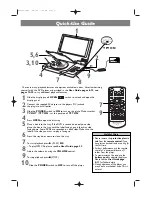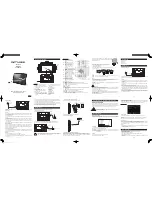
6.6.
connecting equipment to the generator
the generator is suitable for 230V~ and 110V~ appliances.
6.6.1.
Set the selector switch fig.3.27 to the left to use the 110V~ sockets.
6.6.2.
Important:
even though the continuous power of 5000W is shared in this position between the 2 sockets, it is also possible to load
only one socket with 3500W. the total load of two sockets may temporarily reach a maximum of 3500W for 2 min.
6.6.3.
the 110V socket has a rated current of 16A. the load on one socket is 1750W, maximum of 1850W for 2 minutes. in 110V mode,
3500W is not attainable in one socket. the total load on 2 sockets is 3500W continuously. temporarily it is 3700W for 2 minutes
6.6.4.
Set the selector switch, fig.3.27 to the right to activate the 230V~ sockets.
6.6.5.
Important:
this socket may be loaded continuously (s1) with 3600W and temporarily (s2) for a maximum of 2 minutes with 5500W.
8
Do not
connect the generator to the household mains system as this may result in damage to the generator itself or to other
electrical appliances in your home.
6.6.6.
note:
Some electrical appliances (power jigsaws, drills, etc.) may have a higher level of power consumption when used in difficult
conditions. some electrical appliances (for example televisions, computers, etc.) should not be powered by a generator. if in doubt,
consult the manufacturer of your appliance.
6.7.
Overload cut-out
The generator is fitted with an overload cut-out. This isolates the relevant sockets if an overload occurs.
Important! If this happens, reduce the electric power you are taking from the generator or remove any defective connected
appliances.
6.7.1.
230V~ sockets
6.7.1.1.
If an overload occurs, the 230V~ sockets fig.3.3 will be isolated from the supply. You can restart the 230V~ sockets by pressing the
overload switch fig.3.5.
6.7.2.
110V~ sockets
6.7.2.1.
If an overload occurs, the 110V sockets fig. 3.30 will be isolated from the supply. You can restart the 110V sockets by pressing
the overload switch fig. 3.5.
6.7.3.
Switching off the generator
6.7.4.
Before you switch off the generator, allow it to run briefly with no consumers so that it can “cool down”.
6.7.5.
Move the ON/OFF switch, see fig.1.10 to position “OFF” with the key.
6.7.6. close the petrol tap.
7. MaIntenance
note:
switch off the motor and pull the spark plug boot from the spark plug before doing any cleaning and maintenance work on the
equipment.
Important:
switch off the machine immediately and contact your sealey dealer:
in the event of unusual vibrations or noise
If the engine appears to be overloaded or misfires
7.1.
cleaning
7.1.1.
Keep all safety devices, air vents and the motor housing free of dirt and dust as far as possible.
7.1.2.
Wipe the equipment with a clean cloth or blow it with compressed air at low pressure.
7.1.3.
We recommend that you clean the device immediately each time you have finished using it. Clean the equipment regularly with a moist
cloth and some soft soap. do not use cleaning agents or solvents; these could attack the plastic parts of the equipment. ensure that
no water can seep into the device.
7.2.
Air filter see figs 11 & 12.
7.2.1.
Clean the air filter at regular intervals, and replace it if necessary.
7.2.2.
Open both clips, see fig.11.A and remove the air filter cover, see fig.11.B.
7.2.3.
Remove the filter elements, see fig.12.C. Do not use abrasive cleaning agents or petrol to clean the elements. Clean the elements by
tapping them on a flat surface. In cases of stubborn dirt first clean with soapy water, then rinse with clear water and air dry.
7.2.4. Assemble in reverse order.
7.3.
Spark plug see figs.13 & 14
7.4.
check the spark plug for dirt and grime after 20 hours of operation and if necessary clean with a copper wire brush. thereafter service
the spark plug after every 50 hours of operation.
7.4.1.
Open the maintenance flap, see fig.13.E.
7.4.2.
Pull off the spark plug boot with a twist.
7.4.3.
Remove the spark plug with the supplied spark plug wrench, see fig.14.D.
7.4.4. Assemble in reverse order
7.5.
Changing the oil and checking the oil level (before using the machine) see fig.10.
7.5.1.
the motor oil is best changed when the motor is at working temperature.
7.5.2.
only use motor oil (15W40).
7.5.3.
Place the generator on a slightly inclined surface so that the oil drain plug is at the lower end. Open the oil filler plug. Open the oil
drain plug and let the hot engine oil drain out into a drip tray.
7.5.4. After the old oil has drained out, close the oil drain plug and place the generator on a level surface again.
7.5.5.
fill in engine oil up to the top mark on the oil dip stick (approx. 1.1 ltr).
Important:
do not screw the dipstick in to check the oil level, simply insert it up to the thread.
7.5.6. dispose of the waste oil properly.
7.6.
Automatic oil cut-out
light/switch see fig.3.9 & 3.9A
7.6.1.
the automatic oil cut-out responds if there is too little oil in the engine. in this case it will not be possible to start the engine or it will cut
out automatically after a short period of time. it cannot be started again until the engine oil has been topped up, see 7.5.
Original Language Version
© Jack sealey limited
G5501 | issue 2(sP)- 08/11/16
























